Forensics is a vast field of science. There are numerous types of evidence encountered daily. These evidences requires special care to extract evidentiary information that can be used during a case’s trial. This needs special analysis of different types of evidence and is the reason why there are so many branches of forensic sciences.
It took me nearly a week to find each and every major branch of forensic sciences. And another week in writing. Finally, the number came to 47. So, here, you can find a total of 47 forensic science branches, disciplines, and divisions. Happy Reading!
The following table represents various Branches of Forensic Science With their Classification Study.
| Forensic Science Branches | Forensic Study of |
|---|---|
| Computational Forensics | Development of other forensics disciplines |
| Criminalistics | Collect, examine, identify, and compare physical evidence |
| Digital Forensics | Examination of digital products as evidence |
| Environmental Forensics | Uses environmental data as evidence for a case |
| Food Forensics | Inspect food safety and quality issues in legal cases |
| Forensic Accounting | Detection of financial fraud |
| Forensic Anthropology | Examination of Human remains |
| Forensic Archaeology | Search and recovery of burials as evidential material |
| Forensic Art | Application of visual tools (instruction-based face sketching) |
| Forensic Astronomy | Study of historical celestial constellations or art |
| Forensic Ballistics | Analysis of firearms, ammunition, projectile |
| Forensic Biology | Biological fluids and tissues |
| Forensic Biomechanics | Study of muscles to investigate manner of injury/accident |
| Forensic Botany | Plant-based evidence |
| Forensic Chemistry | Arson, drugs, and Petroleum Products and test |
| Forensic Dactyloscopy | Fingerprint and Palmprints for Identification |
| Forensic Diatomology | Study of single-celled algae called diatoms |
| Forensic DNA Analysis | DNA as evidence |
| Forensic Document Examination | Questioned documents, mainly white-collar crimes |
| Forensic Ecology | Analysis of ecological evidence (plants, animals, etc.) |
| Forensic Engineering | Study of mechanical and structural failure |
| Forensic Entomology | Insects to determine post-mortem interval (PMI) |
| Forensic Entomotoxicology | Study of insects in context with toxicology |
| Forensic Geology | Earth materials such as rocks, minerals, etc. |
| Forensic Limnology | Evidence related to freshwater aquatic ecosystems |
| Forensic Linguistics | Study of phonetics and acoustics evidence |
| Forensic Mathematics | Study of mathematic principles and statistics |
| Forensic Medicine | Postmortem examination of a dead body |
| Forensic Meteorology | Study of the impact of weather on a case |
| Forensic Neuropsychology | Behavior, brain functions, and criminal responsibility |
| Forensic Nursing | Nursing skills without damaging integrity of evidence |
| Forensic Odontology | Teeth as evidence mainly for identification |
| Forensic Optometry | Vision-related evidence |
| Forensic Ornithology | Study of birds such as feathers as evidence |
| Forensic Palynology | Study of pollen grains and spores |
| Forensic Photography | Documentation and assessment with photographs |
| Forensic Physics | Use of physics principles such as skid marks, etc. |
| Forensic Podiatry | Study of the foot and shoeprints |
| Forensic Psychology | Use of psychology in answering legal questions |
| Forensic Psychophysiology | Psychological responses to legal questions (polygraph) |
| Forensic Radiology | X-rays and CT scans of body parts as evidence |
| Forensic Sculpture | Development of 3d facial reconstruction |
| Forensic Seismology | Cause of seismic waves and human activities |
| Forensic Serology | Antigen-antibody-based biological test as evidence |
| Forensic Toxicology | Identification of toxins and drugs |
| Trace Evidence Analysis | Hair, glasses, impression evidence, etc. |
| Wildlife Forensics | All aspects of evidence associated with wildlife |
P.S. Duties such as maintaining chain of custody, maintaining integrity of evidence, training to freshers are common ones. So, I am not going to list it down in each forensic branch or diciplines.
1. Computational Forensics
Definition: Computer forensics is concerned with the development of various branches of forensics and solving their problems using computational methods.
Goals and Duties Involved: To use different computational frameworks for the discovery and advancement of forensic knowledge and finding with proper scientific principles.
Computational methods involve modeling, simulation, analysis, and recognition in studying and solving forensic problems.
Some of the major contributors to computational forensics are:
- International Association for Pattern Recognition (IAPR)
- International Workshop on Computational Forensics (IWCF)
Example: Some new advancements are discussed in research papers:
- Art Forgery Detection via Craquelure Pattern Matching [Springer]
- Biografo: An Integrated Tool for Forensics Writer Identification [Springer]
2. Criminalistics
Definition: Study of physical evidence to extract information using scientific means and link them to a crime scene.
Sometimes Criminalistics is also called Forensic Science but technically they are different. According to the American Board of Criminalistics, Criminalists is defined as the profession specifically to evaluate the finding of physical evidence.
Goals and Duties Involved: The main goal is to recognize, collect, identify, individualize, and evaluate information from physical evidence.
Case Examples: All sorts of physical evidence such as hair, glass, blood, tool marks, impression evidence, tire marks, ballistics, etc.
3. Digital Forensics
Definition: The application of the techniques of computer science and digital technology or any electronic forms of evidence that may be used in the civil and criminal court of law.
Goals and Duties Involved: The procedures applied to any type of digital evidence including computers, mobiles, CDs, Hard drives, SD cards, and other digital devices and peripherals for gathering evidence.
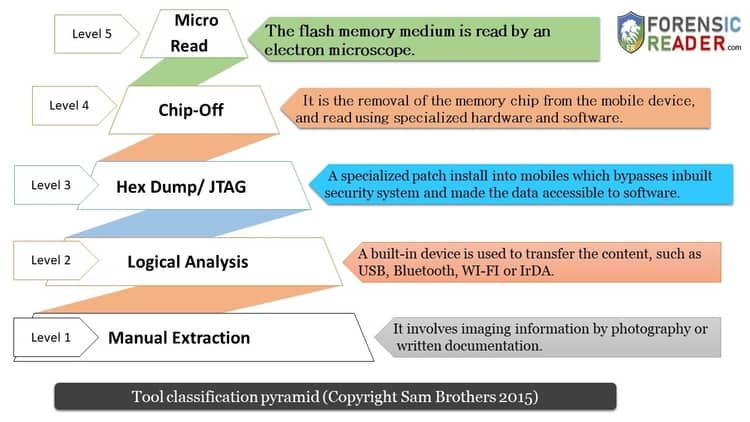
Digital Forensics can further divided into three main categories:
- Computer Forensics
- Mobile Forensics
- Cyber Forensics
- Forensic Musicology: Refers to comparing two pieces of music in cases of alleged copyright infringement.
Real Case Example:
- Recovery of deleted data, decrypting secret messages, hacking, and other cyber securities and their involvement as evidence.
- Police investigators the hard drives and internet search history and found some more suspicious clues that lead to the arrest of the criminal wife “Miriam Helmick” for killing his husband “Alan Helmick.”
4. Environmental Forensics
Definition: Study of environmental data and information using scientific measures involved in civil and criminal proceedings.
Goals and Duties Involved:
- Analyze environmental samples for contamination.
- Allocate responsible organic and inorganic chemicals and link them to specific parties.
- Action plan to collect reference samples from an area.
- Computer modeling, mapping, and photographing of evidentiary areas.
- Sampling, drilling, testing, and other laboratory analysis of samples.
- Predict the spread of pollutants through soil, air, and water with associated time.
Real Case Examples:
- The Exxon Valdez oil spill was the worst environmental disaster in history. The experts trace the chemical back to the Exxon Valdez tanker and also how it disrupts the ecosystem.
- Love Canal disaster, the worst environmental disaster in the US. The chemical waste landfill in Niagara Falls began to leak toxic chemicals that polluted the nearby environment. Forensics reveals the contaminants were from a landfill. (Read full story)
5. Food Forensics
Definition: Food forensics is a specialized field to determine and inspect the food safety and quality issues that are commenced by food authorities.
Goals and Duties Involved:
- What, how, and when a food safety and quality issue is detected?
- Consumer safety levels of organic and inorganic products in commercially packed/unpacked foods.
- Inspect the chemical composition of packed foods.
- Inspects the level of contamination by the container of packed food with variable temperature and time.
- Detects the legitimacy of expired date labels on the packed.
- How do contaminants end up in food products?
- Claims made by companies on trade secrets.
- Wrong representation of food on packet labels.
- Hygiene and microbes during packing.
- Mass food poisoning.
Case Example:
- How an Apple juice company, Odwalla was fined $1.5 million, which was one of the highest fines ever imposed in a food poisoning case. [Read Full Case: E. Coli O157 Outbreak Core Evidence Forensic File Case Study]
6. Forensic Accounting
Definition: Forensic Accounting is defined as the use of accounting or business skills to evaluate questioned financial and accounting activities involved in civil and criminal proceedings.
Mr. Frank Wilson is considered the father of forensic accounting. When forensic accounting is specially used for the determination of fraud it is called Fraud Auditing.
Goals and Duties Involved: To identify, record, extract, report, and verify financial data or other accounting activities for legal disputes and to prevent future financial fraud.
Case Examples: Common Cases in Forensic accounting:
- Criminal Cases: bank fraud, embezzlement, health care and insurance fraud, money laundering, tax evasion, etc.
- Civil Cases: False bankruptcy, lost profit computations, gift, and estate tax valuations, buy-sell agreements, etc.
7. Forensic Anthropology
Definition: Forensic anthropology is defined as the identification and examination of human skeletal remains.
Goals and Duties Involved: Recovering, processing, determining victim characteristics (gender, age, race, height, and physical injuries), and identification of human skeletal remains.
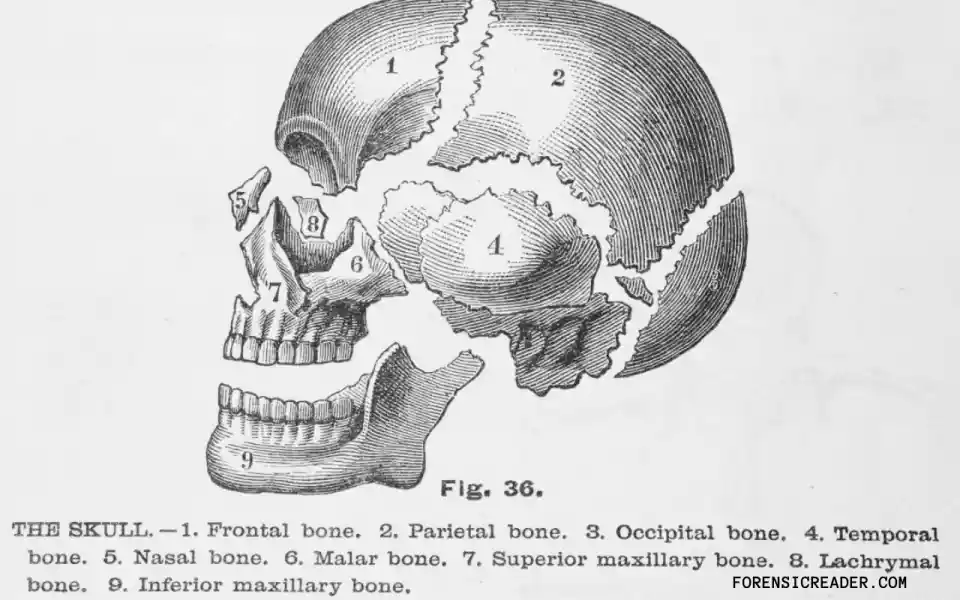
In case of mass disasters, such as plane crashes, one of the main duties of forensic anthropologists is to organize bone fragments.
Forensic osteology: specifically, the study of bones in forensic investigations to comment on physical traits such as height, trauma, age, and gender.
Other subfields of forensic anthropology and archeology are Forensic Taphonomy, which specially deals with the estimation of time since death.
Real Case Examples:
- Determination of age, race, gender, and other physical characteristics from studying skeletal remains.
- In the case of Norman Kloss & Graham King [A Leg to Stand On] Forensic File, forensic anthropologists help to define the height of the victim from the femur bone.
8. Forensic Archaeology
Definition: Forensic archaeology is defined as searching and recovering archeological evidence (buried long ago) for the means of solving criminal and civil cases.
Goals and Duties Involved: The main areas of interest are the systematic methods of locating, surveying, excavating, and documenting burials.
Then the information and facts are used to reconstruct possible events that happened on the site.
A forensic archaeologist’s main job is to find hidden graves and carefully open them with appropriate tools while noting which strata (layers) of soil were disturbed and which artifacts were also left behind.
Case Example:
- Radiocarbon dating
- Excavation of mass graves in Argentina, Rwanda, South Africa, and Eastern Europe [Springer]
9. Forensic Art
Definition: Forensic art employs scientific techniques for the application of drawing, sculpture, and other visual tools to forensic casework.
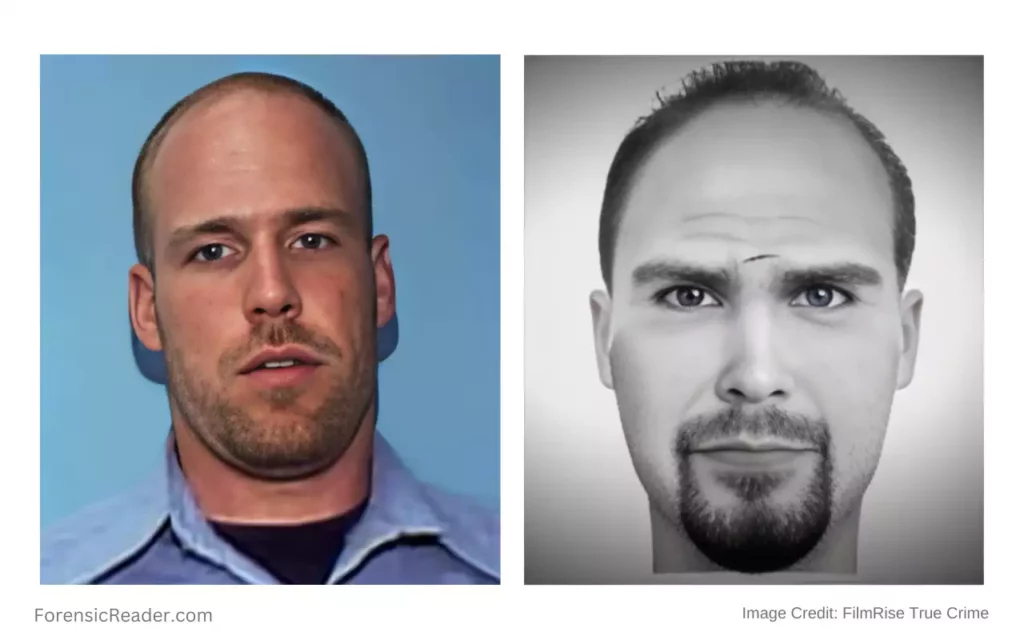
Goals and Duties Involved:
- Creation of a sketch of a missing person from imagery composite of witness statements.
- Image enhancement from images by the surveillance camera.
- Creation of the aging progression of a person from their childhood or adulthood photographs.
- Facial reconstruction (check forensic sculpture).
- Superimposition of photographs with a skull.
- Negative marking of tool marks on a surface.
- Preparation of visual aids to represent analysis to jury and courtroom presentation.
Real Case Example:
- In a case of A Touching Recollection of Forensic Files, Megan is able to provide imagery description with the help of a sketch artist that able to develop Craig Bailey’s sketch.
- Why is eye witness not reliable as forensic evidence? Read Paul Taylor And Kathy Woodhouse case study.
10. Forensic Astronomy
Definition: Forensic Astronomy employs astronomy techniques to determine or discover historical celestial constellations or art to solve the problem of law.
Goals and Duties Involved: The main goal is to assist and determine the specific times in the past and their respective appearance of the sky and planetary configuration, and evaluate their characteristics such as date, time, origin, etc.
Forensic Astronomy is extremely rare and thus not known or used in regular civil or criminal cases.
Case Examples:
- Investigation of past planetary or celestial configurations in older paintings.
- Book on Forensic Astronomy: Celestial Sleuth: Using Astronomy to Solve mysteries in Art, History, and Literature, [Springer]
11. Forensic Ballistics
Definition: Forensic Ballistics deals with the study and analysis of firearms and ammunition as physical evidence involved in criminal or civil cases.
Goals and Duties Involved: To determine and individualize weapons and ammunition that are involved in forensic cases while studying the projectile behavior in terms of internal, external, and terminal ballistics.
There are three subdivisions while studying the firing action of a firearm in Forensic Ballistics:
- Internal Ballistics: from ignition till bullets leave the barrel.
- Exterior/External Ballistics: behavior of projectile after leaving the barrel.
- Terminal Ballistics: impact of the projectile when hit the target.
- Wound Ballistics: if the target is a human or animal body.
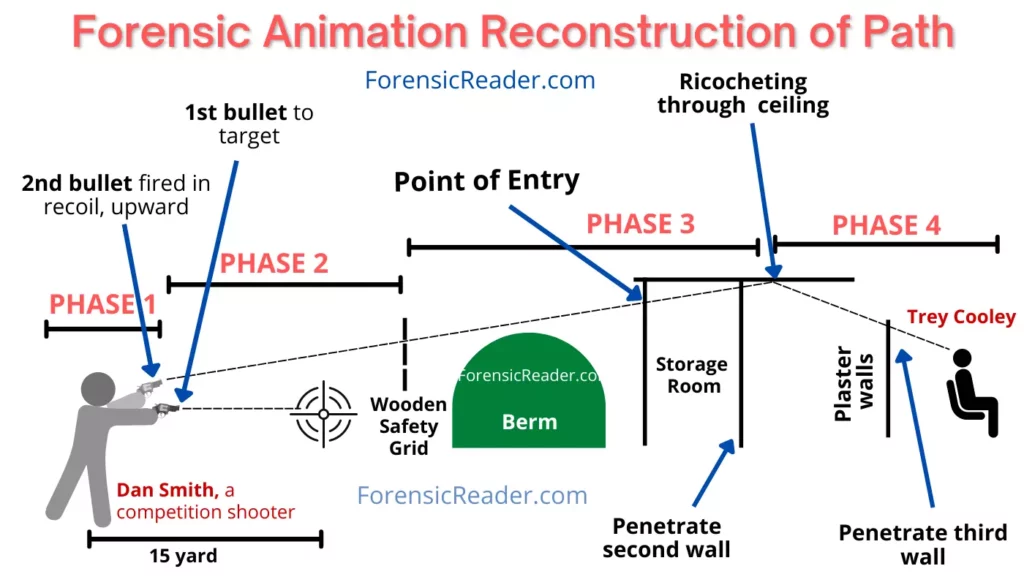
Common duties involved in forensic ballistics are:
- Whether a bullet is fired from a specific weapon.
- Identify, the type, and caliber of firearm and ammunition
- Restoration of the serial number on firearms.
Real Case Example:
- How a 20-year-old bullet help in the identification of a criminal. [Read full case summary: Alan & Miriam Helmick Case [Gone Ballistic] Forensic Files]
12. Forensic Biology
Definition: Forensic Biology concerns the analysis of biological evidence using biological and biochemical techniques to assist criminal investigators in linking suspects or victims to crime scenes.
Goals and Duties Involved: Use biological and biochemical techniques to evaluate biological composition or characteristics from tissues and bodily fluids that were left behind during a criminal act.
There are three major subdivisions of Forensic Biology:
- Forensic Serology
- Forensic DNA Typing
- Forensic Entomology
Case Examples:
- Test for detection of blood or saliva in a sample.
- Ken Bogan, a DNA analyst, is able to recover DNA from a cigarette butt and help investigators in the identification of criminals. [Home Evasion Forensic File Case: Jonathan Binney Killer And Judy Southern Victim]
13. Forensic Biomechanics
Definition: Forensic biomechanics is the science of mechanical principles applied to biological tissues involving mainly muscles to investigate the manner of injuries and accidents.
It primarily focuses on muscle-driven motions.
Goals and Duties Involved:
- Reconstruction of how an injury might be inflicted.
- Force or mechanism that causes injury or shock.
- Trauma during violence or accident.
- Bone trauma to describe and interpret intrinsic (size, geometry, elasticity) and extrinsic (magnitude, direction of force) factors.
- Examination of pattern injuries and bone fractures.
- Determination of cause and manner of death in skeletonized or highly decomposed bodies.
- Reconstruction of injuries and accidents.
Real Case Example:
- Person ‘A’ claimed that he killed person ‘B’ in self-defense. He told investigators that person ‘B’ approached him and tried to harm him with a knife and in self-defense, he killed him. However, forensic biomechanics theory suggested that person ‘B’ is falling backward. This contradicts the self-defense theory or more likely offensive injuries.
14. Forensic Botany
Definition: Forensic botany deals with the study and analysis of plants or plant-based evidence in legal matters.
Goals and Duties Involved: To examine, classify, identify, and evaluate other aspects of botanical evidence involved in the case. Some of the main duties are:
- Estimating the probable time of death.
- Ascertaining if the body was moved (primary or secondary crime scene)
- Determining what a person had eaten prior to death.
- Analysis of active principles and plant poisons.
- Person died indoors, outdoors, or in a particular location.
- Dendrochronology: the study of tree rings to estimate the age, species, or growth rate of trees and shrubs.
Case Example:
- A wood or leaves found clinging to a body can reveal information about where the victim had been recently visited.
15. Forensic Chemistry
Definition: Forensic Chemistry is the study and analysis of techniques to identify chemical components and their concentration in a given forensic evidence.
Goals and Duties Involved: The goal is to evaluate the chemical characteristics of given evidence samples using qualitative and quantitative measures using both traditional wet chemical and proper instrumental analysis.
- Wet Chemical Methods: The test involved adding a reagent to form a characteristic color change or formation of a new compound.
- Instrumentation: Using specific instrumentation such as Gas chromatography with Mass Spectrometry (GC/MS), HPLC, Capillary electrophoresis, and Scanning Electron Microscopy (SEM) coupled with X-ray Fluorescence (XRF)

Some common evidence analyzed are:
- Characterization of drugs
- Arson case analysis
- Accelerants, and explosive residues analysis
- Paint analysis
- Polymers and fibers analysis
Real Case Examples:
- Specific tests to identify substances such as drugs, petroleum products, etc.
- Read case A Bitter Pill To Swallow [Forensic Files] Case Study that uses GC MS for the identification of drugs given by Dr. Maynard Muntzing.
16. Forensic Dactyloscopy/Dermatoglyphics
Definition: Forensic Fingerprints or Dactyloscopy is the analysis and classification of fingerprint patterns to evaluate the ridge characteristics to aid in civil and criminal investigations.
Dermatoglyphics is the study of fingerprints and their pattern. The term is closely related to Dactyloscopy.
Goals and Duties Involved: The duties involved collecting, preserving, casting, and lifting fingerprints ridges (also palm prints) as evidence to perform tasks such as
- Converting ridge characteristics into 10-digit fingerprint cards.
- Classifying ridge patterns using ridge tracing and ridge counting.
- Comparing fingerprints against databases such as AFIS
- Individualization using fingerprints.
- Research and development of classification systems such as the Henry classification system.
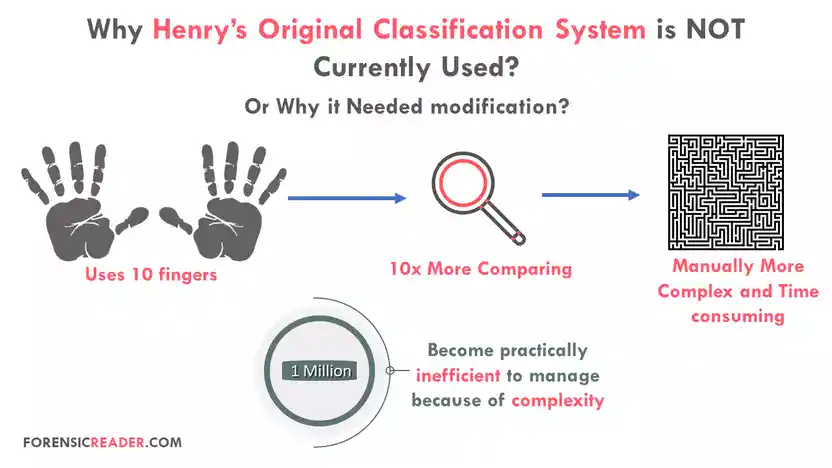
Cases Examples:
- Collecting and developing latent prints from the crime scene.
- How fingerprints from a crime scene are used to identify the culprit. Read the full case study Over a Barrel [Forensic Files] Case: Robert Wesley Cowan and Alma Merck.
17. Forensic Diatomology
Definition: Forensic diatomology is the study of diatoms (single-celled algae) in linking the victim to a specific water body (or location) to aid a forensic investigation.
Diatoms can provide crucial evidence in cases involving drowning or bodies found in water, as their unique shapes and species can indicate the location and time of death.
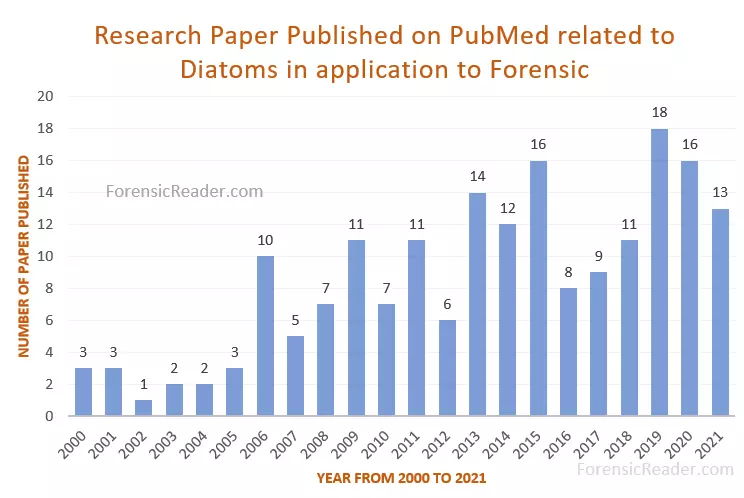
Goals and Duties Involved:
- Collect and analyze diatom samples from bodies of water bodies such as lakes, rivers, and ponds.
- Compare diatoms found in the human body with reference samples collected from water bodies.
- Analyzing using a microscope to check the shape, size, or outer covering structure.
- Research and development of diatomic databases for references.
Read Case Examples:
- Christopher Green, Brian Davis, and Jason culprit caught using Diatoms [Reel Danger Stenger’s Pond Attack Case Study]
- Also, read a list of 8 famous cases that involved diatoms as evidence.
18. Forensic DNA Analysis
Definition: Forensic DNA analysis concerns the DNA aspects of biological samples for criminal investigation or other legal matters.
It is a subdivision and is mostly considered a part of Forensic biology.
Goal and Duties Involved: To identify, analyze, and interpret DNA samples of biological evidence by using principles and techniques of biochemistry, molecular biology, genetics, and statistics.
Some common use of Forensic DNA Analysis:
- Identification of unknown individuals
- Paternity and family relationship cases
- Identification of genes of bacteria and other microorganisms.
Cases Examples:
- Comparing unknown samples with DNA databases such as Combined DNA Index System (CODIS).
- Solves paternity and maternity cases as 50% of genes are from each parent.
19. Forensic Document Examination
Definition: Forensic Document Examination of Questioned Document is associated with the evaluation of documents that could be used as evidence in court or aid criminal investigation.
Goal and Duties Involved: Mainly used to deal with white-collar crimes and sometimes other malpractices to determine whether a document is original, forged, or altered.
Some duties involved are:
- Collection of question documents such as seals, paper, deeds, checks, rubber stamps, watermarks, bank and financial statements, and machine-generated documents.
- Collection of writing instrumentation such as pens, markers, etc.
- Determine the authenticity of documents.
- Determine the age of documents.
- Handwriting and signature analysis.
- Checks for modification, substitutions, or eliminations of a part of the document.
- Obtaining reference samples for comparison.
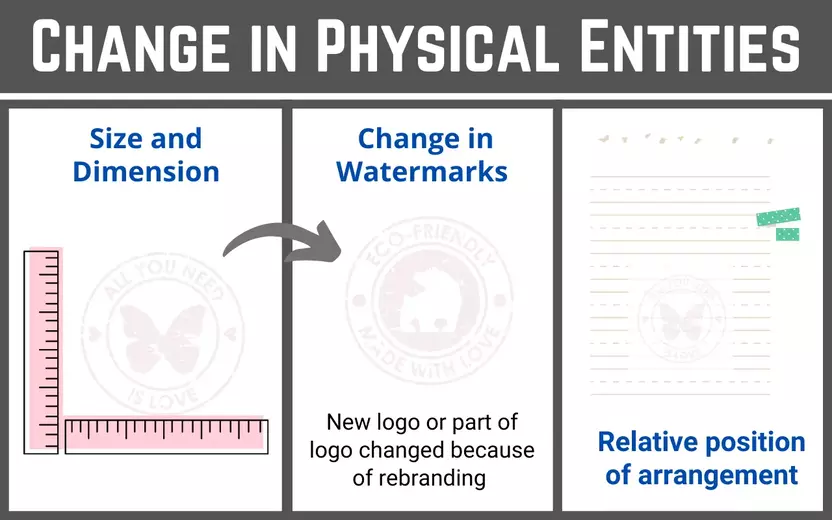
Case Examples:
- Whether a signed document is originally signed by a legit author or a copy.
- Detection of fake currencies.
- Decipherment of indentation writing or charred documents.
20. Forensic Ecology
Definition: Forensic ecology concerns the analysis of ecological evidence such as plants, animals, and other natural materials to solve the investigation question in civil and criminal cases.
Forensic ecology can be substituted by forensic botany, forensic biology, and wildlife forensics. However, you can be considered as all three (botany, biology, and wildlife) have an overlapping window that constitutes forensic ecology
Goals and Duties Involved:
- Identification of ground disturbance due to clandestine graves.
- Aerial photography to detect disturbed areas.
- Areas with missing or disturbed vegetation.
- Use of ground penetrating radar (GPR) for detecting buried graves.
- Pipe dugs to release scent for ground and search using cadaver dogs.
- Dumping of toxins in landfills that affects vegetation and fresh water.
- Deliberately cutting off trees or actions of nature such as storms.
- Movement of water such as tides and currents of the bay.
- Ecological surveys and research.
Real Case Examples:
- A floating body was found on San Francisco Bay. Forensic ecologists study the current and high tides region and determine the possible region where the body was dumped and at what time. This leads to the identification of the body.
- How is ground-penetrating radar used to find a burial site? Read More: Bill Bruns And Pearl Smith [Missing Pearl] Forensic Files Case Study.
21. Forensic Engineering
Definition: Forensic engineering offers evaluation and opinions on engineering issues related to criminal negligence/behavior, or civil liability claims.
Goal and Duties Involved: To investigate why buildings, vehicles, machines, manufactured goods collapse, and brakes, fail to do what they are intended for.
In addition, they mainly focused on the analysis of physical evidence to determine the causes of accidents and operative functional failures.
It can be further subdivided into branches such as Forensic Mechanical engineering, Forensic electrical engineering, etc.

Case Examples:
- Why fire system doesn’t work during a fire?
- Why did a train derail?
- Why did a plane crash?
- Why does toxic waste leak from sealed containers?
22. Forensic Entomology
Definition: Forensic Entomology is the study of insects (mainly arthropods) in relation to criminal and civil proceedings.
Goal and Duties Involved: To determine the time of death based on the exposure time to the surrounding environment or crime scene.
Another important factor is determining the primary and secondary crime scene. If the body has very few arthropods in a moist and humid region, it means the body is moved or dumped from a controlled or dry environment.
Time since death–or post-mortem interval (PMI)– can be evaluated by studying:
- stages of development of certain insect species.
- Types of insects invade a body after death.
- Location of the body recovered from.
- Depending on the state of decay.
Case Examples:
- Flies (house or flesh flies) were the first to colonize the decomposing human body.
- House flies pupa on a body is an indication that the body is about 5 days old.
23. Forensic Entomotoxicology
Definition: Forensic entomotoxicology concerns the analysis of insects in context with toxicology, to determine what substance they ingested while feeding on the deceased body.
Entomotoxicology is valuable when the recovered body is in a late decomposition phase where standard toxicological analysis of blood and tissue can’t possible.
So, when the insects such as house fly feed on toxins or drugs, it influences their growth and development which on careful analysis would result in PMI.
Goals and Duties Involved:
- Collection of insects from the body as well as the surrounding area as reference.
- Identification of insects and stages of development.
- Extraction of toxins from insects’ bodies.
- Identification of substances ingested.
- The concentration of drugs or toxins in insects and their relation actually ingested by the deceased person.
Case Example:
- A teenage boy was missing for six weeks. Later, his body was recovered from a forest. There is no sign of injuries or fractures. Tissues and blood samples can’t be possible for toxicological analysis. However, insects recovered from his body determined that he was poisoned. The case was charged with homicide.
24. Forensic Geology (Geo Forensics)
Definition: Forensic Geology is the study of rocks, minerals, soils, petroleum products, and landforms as evidence in civil or criminal cases. It is also called Geoforensics. A more often forensic branch specifically for soil analysis is known as soil forensics or forensic pedology.
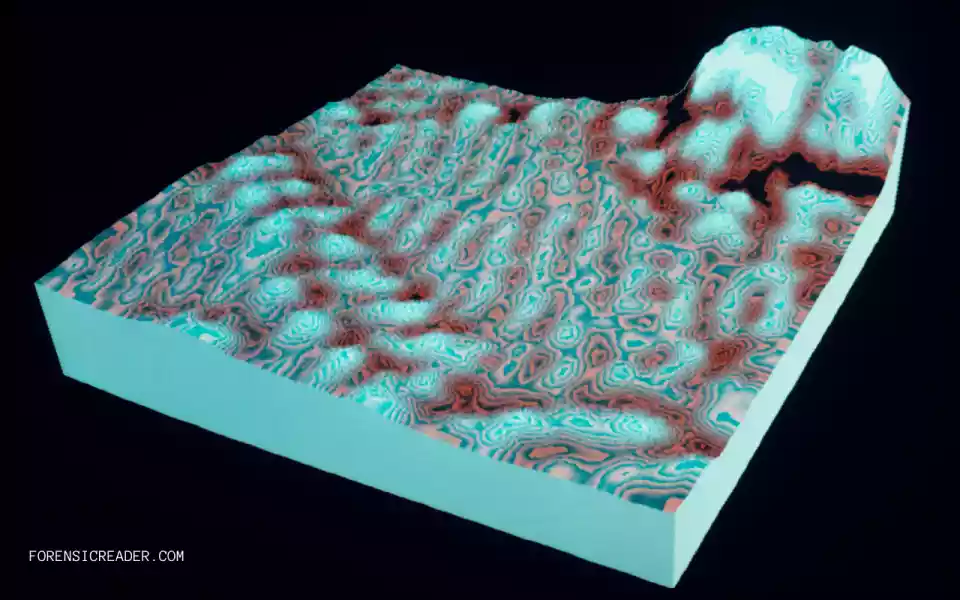
Goal and Duties Involved: Primarily to study soils to determine their origin. Other duties included:
- Collecting soil or mineral samples from investigation sites.
- Study earth material samples to identify their unique characteristics.
- Analyze soils as the base of construction and whether the soil profile was suitable for construction sites or not.
- Study soil or stones used in construction to determine the cause of a structural collapse.
Case Example:
- A case that is solved using analyzing the soil and its origin. [Read More: Charlene And Brian Hummert [A Tight Leash] Forensic File Case Study]
25. Forensic Limnology
Definition: Forensic Limnology is the study of freshwater ecosystems for linking a crime to specific aquatic ecosystems and helping in criminal investigation.
It includes the study of freshwater ecosystems such as lakes, streams, marshes, and ponds.
Goals and Duties Involved:
- Study of freshwater microscopic and macroscopic organisms.
- Analyses water samples for specific organisms to differentiate ecosystems from other water ecosystems.
- Classification and identification of diatoms (forensic diatomology) and other algae.
- Identification of toxins and pollutants in water.
- Especially cases of antemortem or post-mortem drowning.
Case Example:
- Tons of fish were found dead in a regional pond. Forensic limnology analysis stated that there is a high concentration of organic mercury. The case is registered against a company for dumping toxic waste into a pond. They were charged with a $100,000 fine.
26. Forensic Linguistics
Definition: Forensic linguistics involves phonetics and acoustics evidence to analyze and assist criminal or civil cases.
A sub-branch of forensic linguistics is Forensic Phonetics, which deals with identification using voice.
Goal and Duties Involved: Some common duties are:
- Analyze language for communication patterns.
- Identify the authorship of a voice message or recorded conversation.
- Compare audio from anonymous messages, threats, or harassment cases.
- Analyze the language written in contracts, agreements, or other questioned documents.
- May be used to analyze online communication, including social media posts, to investigate cybercrime or harassment cases.
Case Example:
- In a case, forensic linguistics expert Dr. Harry Hollein compared suspect audio with the recorded voice of a person who informed 911 about the criminal activity. It matched perfectly. Read the case: A Bag of Evidence Forensic Files Case: James Crowe Killer And Jessica Knott Victim
27. Forensic Mathematics and Statistics
Definition: The use of mathematical principles such as trigonometry, statistics, probability, graphical representation, etc. for the interpretation of results from a survey or forensic analysis is called forensic mathematics.
A sub-branch of mathematics is statistics. So, when specifically stats are used as an application to forensics, it is called Forensic Statistics.

Goals and Duties Involved:
- Almost every forensic branch needs mathematics and statistics principles.
- In Forensic anthropology, is used to calculate height from bones.
- Trigonometry measurements are used in blood spatter analysis, tool marks, and impact injuries.
- Determining the probability of uncertainty (Bayesian theorem).
- Comparing hypotheses based on prior knowledge gathered from evidence.
- In DNA analysis, statistics are used in DNA Typing, Population genetics, and estimating Gene frequencies.
- Calculation of average, and standard deviations used in replicated measurements of the same sample.
Case Examples:
- Determining the range of the projectile.
- Solving Problems Related To Forensics Using Mathematics.
28. Forensic Medicine
Definition: Forensic medicine (also called forensic pathology) deals with the examination of a dead body to determine the cause and manner of death in criminal cases or unexpected death.
Goals and Duties Involved:
- Performing autopsies and collecting body organs or fluid for further analysis (mainly toxicology).
- Inspect the injuries and what is the probable cause of death.
- Preparation of autopsy reports.
- Determining other characteristics traits such as occupations.
- Determine the time since death by analyzing characteristic features such as rigor mortis, algor mortis, etc.
Real Case Example:
- In a case where two witnesses stated that the victim died because of a runover by a pickup truck. But as per forensic pathologists, the death may be due to blunt force trauma to the head. Read the full case: Joseph Wehmanen & Erik Schrieffer [A Clutch Of Witnesses] Forensic File Case
29. Forensic Meteorology
Definition: Forensic meteorology uses weather and weather events to evaluate the condition in a particular time and location that is linked to a civil or criminal investigation.
Goals and Duties Involved:
- Gathering information about the type of weather on the day of the crime or accident.
- Investigating wildfires and aviation accidents involves bad weather.
- How does the weather affect the crime scene?
- How does weather influence the outcomes of an incident?
Case Example:
- In one case, a person was accused of starting a wildfire. The investigating report by a forensic meteorologist stated that the wind direction of that day was in the opposite direction. So, even if he set the fire, the fire must have spread in the opposite direction. And he was freed from charges.
30. Forensic Neuropsychology
Definition: Forensic Neuropsychology focuses on behavior as indicators of the brain and nervous system function, and their uses as evidence in civil and criminal cases.
It is a subdivision of forensic psychology that I’m going to state later.
Goals and Duties Involved:
- Examination of the impact of brain injury or other neurologic disorders on cognitive, emotional, and behavioral functioning.
- Rehabilitation programs for the survival of victims of mental trauma.
- Comment on competency to stand a trial, criminal responsibility, and civil capacity.
- Research and development of neuropsychological tests, brain imaging, and mapping.
Case Example:
- A man was charged with murder by negligent driving. However, he claims memory loss because of the accident. Forensic neuropsychologists also certified that it was a genuine case of memory loss. The trial went as per the expert witness statement and he was freed and sent to a medical aid facility.
31. Forensic Nursing
Definition: The application of nursing skills without (or at minimum) damaging the integrity of forensic evidence.
There are two sub-branches in forensic nursing:
- Clinical Forensic Nursing (CFS): Focuses on nursing in special treatment facilities such as emergency rooms, prison clinics, and forensic psychiatric hospitals.
- Sexual Assault Nurse Examiner (SANE): Nurse trained to collect evidence and counsel victims of sexual crimes.
Goals and Duties Involved:
- Provides support and care for victims.
- Collection of evidence such as physical (on clothes, nails, body, etc).
- Noticing behavioral evidence in the form of communication, written or any sign language.
- Assist medical examiner during autopsies and death investigations.
- Document injuries.
Case Example:
- In a prison clinic, a prisoner was admitted with pain in the stomach. Soon he started vomiting. The vomit has a strong garlic smell, an indication of arsenic poisoning. A forensic nurse emptied his stomach using a gastric lavage system. He collected the stomach fluid and sent it for toxicological analysis.
32. Forensic Odontology (Forensic Dentistry)
Definition: Study of teeth, alignment, and overall structure to identify a specific person that is questioned by legal proceedings.
A subfield of forensic dentistry is Forensic odontostomatology. It specifically concerns the study of teeth, jaws, and oral structures for identification.

Goal and Duties Involved:
- Identify human remains mainly in case of mass disasters such as airplane crashes.
- Identification of bite marks left on a victim and comparison with the tooth alignment.
- Analyzing and comparing dental records using x-rays and dental casting.
- Age estimation from teeth.
Case Examples:
- Identification of victims of the 9/11 attack.
- Dr. Ronald Gier, a forensic odontologist able to identify decomposed bodies using their dental alignments. [Read the full case: Why does Ray Need Workers? How did he Choose and Hire them?]
33. Forensic Optometry
Definition: Forensic Optometry concerns the analysis of vision-related evidence to assist criminal investigators or any other legal proceedings.
Goals and Duties Involved:
- Eyewitness accountability of what they saw.
- False accusation of a visually impaired person linking to a crime.
- Assessment of visual perception and accuracy in certain lighting conditions.
- Examination of skeletal remains mainly eye sockets.
- Determine the possibility of an incident at night.
- Research and development of Iris and retina recognition system
Case Example:
- In a car accident case, a driver had a visual impairment that hindered his ability to drive mostly at night. According to a forensic optometric report, he was held liable for the accident and charged with a respective fine.
34. Forensic Ornithology
Definition: Scientific study of birds, including various species’ feathers, beaks, wings, or other parts to answer criminal and civil investigation questions.
Goals and Duties Involved:
- Microscopic examination of feather structure for identification of birds.
- Investigating evidence of illegal selling and trading birds.
- Accident cases involving birds such as striking birds with planes result in a crash.
- Pet birds and their feathers on clothing link suspects or victims to a crime scene.
- Analysis of feathers and comparison with the Feather Identification Laboratory (FIL) database.
- Identification of endangered species.
- Determining the cause of death of endangered species of bird.
Real Case Example:
- Emergency landing by a United Airlines flight because of a suspected bird strike. [Read full story].
35. Forensic Palynology
Definition: Forensic Palynology refers to the scientific study of pollen and spores evidence used to assist the investigation by a court of law.
Pollen and spores are microscopic reproductive plant particles that are spread by wind, water, or insects.
Goals and Duties Involved:
- Examination of pollens and spores through microscopes.
- Identifying unique characteristics to compare with control samples.
- Types and genera of plants that produce pollen.
- Pollen distribution area based on location and time of year the crime occurred.
- Possibility of finding pollen at a crime scene in contrast to their seasonal variations.
Case Example:
- Let’s say that person ‘A’ was found to be unconscious in the Mississippi area. He was brought to the hospital but declared dead. Later with pollen evidence on clothes. The probable location is Missouri, which is a thousand miles away. On searching for a missing person list in local police, he was identified as a local of Missouri.
36. Forensic Photography
Definition: Forensic Photography applies to the technical skills and knowledge of anatomy and case requirements to take a photograph that conveys the correct representation and is used as evidence in investigation and court of law.
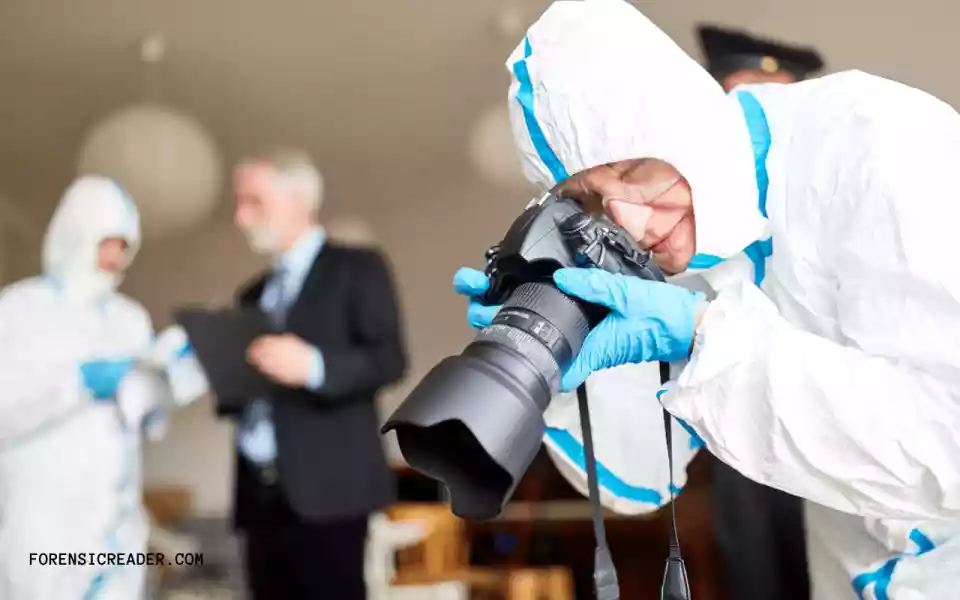
Goals and Duties Involved:
- Taking photographs with actual colors and rightful contrast.
- Able to take wide-angle, mid-angle, and closeup photographs.
- Take photographs to define correct information in several conditions such as indoor crime scenes, in the dark, and medico-legal photographs (injuries).
- Clear images of every piece of evidence such as fingerprints, tool marks, bullets, etc.
- Photographing evidence under different lightings such as UV, IR, and X-rays.
- How to use microscope adapters and their respective analysis.
Case Examples:
- Documentation of every crime scene requires a forensic photographer.
- Forensic Photography & Scales: How To Use Them Effectively With Examples
37. Forensic Physics
Definition: Forensic Physics deals with the use of scientific knowledge of physics in the investigation and adjudication of criminal and civil laws.
Goals and Duties Involved:
- Analyze the trajectory, speed, and impact velocity of the projectile
- Determining the speed of a car using skid marks on roads
- Blood spatter analysis
- Microscopy, spectroscopy, and imaging
- Road accident reconstruction
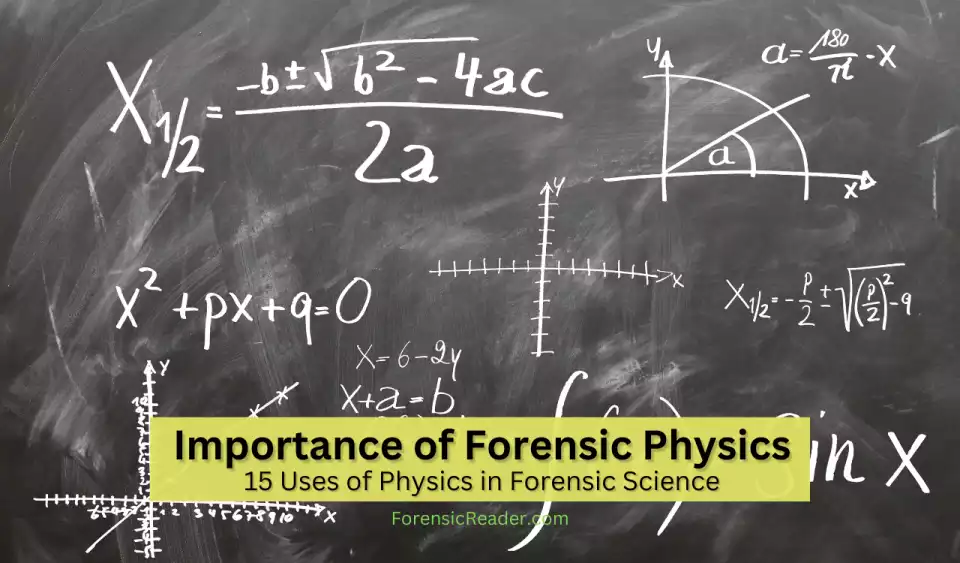
Case Examples:
- Read the case of Trey Cooley [The Magic Bullet] and the work of forensic laser 3d reconstruction animation expert, Steve Irwin, to trace down the path of the bullet that hit Trey Cooley’s forehead.
- Forensic Physics Importance: 15 Uses of Physics in Solving Forensic Cases
38. Forensic Podiatry
Definition: Forensic Podiatry involves the analysis of footprints and shoe prints to link a criminal or victim to a crime scene and solve other legal matters.
Goal and Duties Involved:
- Collect and lift footprints and shoe prints from various surfaces such as snow, soil, etc.
- Use of ESDA for lifting dusted footprints over flat surfaces.
- Use casting materials or simple lifting measures to collect prints.
- Development of latent footprints on flat surfaces
- Analyze foot injuries such as bruises or fractures to determine causes.
- Determine the height, age, gender, and other characteristics from footprint or ankle bone remains.
- Collecting reference samples for footprints
- Matching shoe prints with databases.
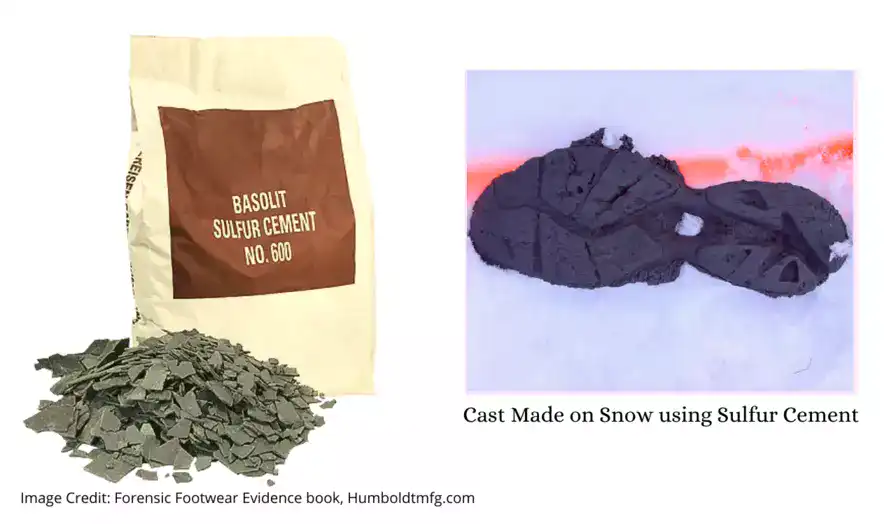
Real Case Examples:
- Jason & Ken MacLennan [Shoot To Thrill] Forensic File Case: How Shoe marks are evidence.
- Identification of criminals from pressure points on the shoe sole. Shirley Duguay & Douglas Beamish [Purr-Fect Match] Forensic Files Case.
39. Forensic Psychology
Definition: Forensic Psychology applies to the scientific knowledge of studying the human mind and behavior to the legal issues pertinent to civil and criminal cases.
A very relative branch is Forensic Psychiatry.
Difference between Forensic Psychology and Psychiatry:
Difference 1: A forensic psychiatrist is a person who is more qualified to practice medicine and able to prescribe medication for mental disorders than psychologists.
Difference 2: He/she has first qualified in medicine and then taken professional training to qualify as a psychiatrist. While psychologists first qualified as psychologists and then trained at the postgraduate level to develop necessary specialty competencies.

Goals and Duties Involved:
- Post-traumatic stress disorder in victims, judicial officers, and culprits after punishment as sentencing (prison time).
- Reliability of witness, victim, or suspect statements related to crime.
- Reliability of criminal responsibility and civil capacity.
- Reliability of jury and decision-making abilities.
- Validity to stand trial for an insanity plea.
- Assessing a person’s behavior in a pressure situation (mainly violent).
- Conduct research such as the effect of various punishments on the mental health of the culprit.
- Developing and conducting research on common issues such as violence, and discrimination in a workplace or prison.
Real Case Examples:
- 14 Importance of Forensic Psychology and Duties of Forensic Psychologists with example.
- How Dean Corll [The Candy Man] became a Serial Killer?
40. Forensic Psychophysiology
Definition: Forensic Psychophysiology is the study of relationships among emotional, or mental phenomena and physiological responses (heart rate, blood pressure, skin conductance, etc) to answer questions related to legal investigation.
A closely related sub-field is Forensic Deception Analysis, which involves detecting deception by statements given by suspects or witnesses without polygraphs.
Goal and Duties Involved:
- Preparing a control question for various psychophysiology tests.
- Conducting polygraph tests (also called lie detection instrumentation)
- Conducting Laser Doppler vibrometry (measure blood flow or fluid vibration in the body)
- Conducting Skin Conductance Response (SCR) test, Galvanic skin resistance, and electroencephalography (EEG).
Real Case Example:
- A culprit named Bill refused to take a lie detector test. This raised more suspension against him and he became the prime suspect which eventually led to his arrest for killing his wife. Read the full case study: Bill Bruns And Pearl Smith [Missing Pearl] Forensic Files Case Study.
41. Forensic Radiology
Definition: Forensic Radiology is defined as the application of medical and dental radiology (mainly X-rays and CT scans) to forensic works. It is also called forensic radiography and when in contrast to a dead body it is called a virtual autopsy.
The most commonly used instrumentation in Forensic Radiology are Ultrasound, Magnetic Resonance Imaging (MRI), fluorescent imaging, Computed Tomography (CT) scans, and Nuclear Imaging techniques.
Goals and Duties Involved:
- Conducting various radiological examinations.
- Interpretation of scan results for identification purposes.
- Identification of fractures and malformation by reading scan results.
- Identification of individuals using Dental radiography for mass disaster cases.
- Angle of the impact of the projectile that helps in defining its trajectory.
- Malpractice or negligence during surgery.
Real Case Example:
- In a case of child abuse, a mother was arrested. The radiograph shows multiple healed fractures over the upper and lower limbs. A case was registered, and the child’s sole custody was handed over to the child’s father.
42. Forensic Sculpture
Definition: The application of computerized tools or artistic skills to develop a 3d facial reconstruction of a person from a skull or old 2d drawing to aid in the identification of skeletal remains or suspects in a criminal investigation.
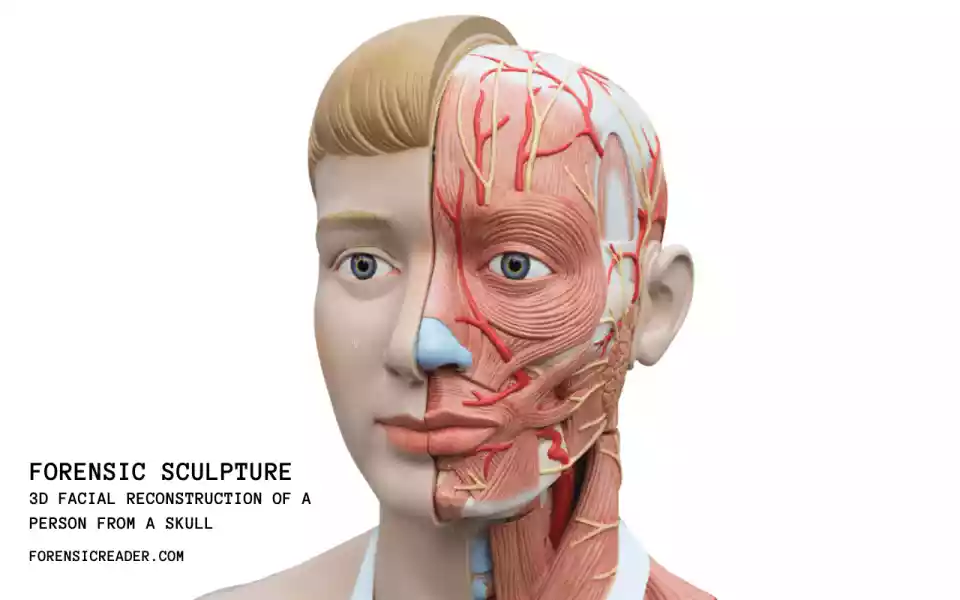
Goals and Duties Involved:
- Creation of a close likeness face from information provided or obtained.
- Ability to change the aging process such as adding or removing hairs, eyeglasses, wrinkles, injuries, etc.
- Creating replicas of skeletal remains (skull) in case of fragile bones.
- Photogrammetry: a technique for creating 3D reconstructions information of 2D images.
Case Example:
- A highly decomposed body was found in the woods, with careful preparation of sculpture with skull and tissue depth markers, forensic sculpturists were able to produce a likeness photograph that later identified as a local from Alaska.
43. Forensic Seismology
Definition: Forensic Seismology involves the impact of seismic waves mainly generated by human activities as evidence in the investigation of criminal cases.
Goals and Duties Involved:
- Analyze seismic waves generated from an explosion, either controlled (structure demolishing) or terrorist attack.
- Seismic waves generated during mining demolishing activity.
- Insurance claim from human-generated seismic waves.
Case Example:
- Investigation of illegal mining that cost the lives of the workers, making it a national matter. Forensic geologists, majorly experts in seismology, were called. They handed over the report to the prosecutor, and a criminal case was filed against illegal mining and those responsible for workers’ lives.
44. Forensic Serology
Definition: Forensic Serology is a subdivision of biology that specially focuses on blood and body fluids as the biological evidence and their antigen-antibodies reaction.
The word “serology” derives from the serum portion of blood which is a source of antibodies.
Goals and Duties Involved: Study and evaluate the reactions between antigens and antibodies in body fluids such as antigen-antibody reaction in the ABO blood group system. Another main goal is to identify the blood origin.
Case Examples:
- Determine whether a given blood sample is of human origin or not based on antigen-antibodies reaction.
- Confirmatory Test For Blood: 7+ Important Forensic Medicine Tests
45. Forensic Toxicology
Definition: Forensic toxicology concerns the biological samples especially from autopsy to determine the presence of toxins and abusive substances as evidence in workplace drug testing, civil, and criminal cases.
Goals and Duties Involved:
- Analyze the biological samples for abused substances such as drugs, alcohol, and other toxins.
- Detection of drug metabolites and active principle concentration.
- Path of administration of drugs: inhaled, ingested, or intravenous.
- Origin of the drug: therapeutic tablets or street drugs.
- How did the person die? The influence of drugs or toxins on the body.
- Estimating the manner of death.
Real Case Examples:
- Rod McCutcheon, a toxicologist, detects high levels of arsenic in Norton sister’s ashes. Culprit Tim Scoggins was found guilty and sentenced to two life imprisonment. Read Full Case: Norton Sister, Olgie Nobles & Tim Scoggin [Penchant for Poison] Forensic Files Case.
- Why did Rajneeshee And Anand Sheela poison the residents of Dalles, Oregon with Salmonella? Read full case: Bio-Attack [Forensic Files] Rajneeshee And Anand Sheela Case Study.
46. Trace Evidence Analysis
Definition: Forensic study of minute physical evidence at a crime scene is called trace evidence. Some examples of trace evidence are hair, glass, fiber, pieces of paper, impression, powder residue, soil, minerals, plastic bags, etc.
Goals and Duties Involved:
- Trichology: Scientific study of hair and scalp.
- Cheiloscopy: the study of lip prints.
- Study of paint chips.
- Identification of powder residue.
Case Example:
- How a pair of shoes and socks help in the identification of a criminal [Read full case A Cinderella Story [Forensic Files]: Janet and Thomas Jabin Berry Case.
47. Wildlife Forensics
Definition: Wildlife Forensics assists law enforcement agencies with all aspects of evidence in association with endangered animals, plants, and fishes.
The U.S. Fish and Wildlife Service (FWS) and Society for Wildlife Forensic Science (SWFS) are the two dedicated group of forensic practitioners that works on both national and international cases related to wildlife.
Goals and Duties Involved:
- Analysis of animal tracks and digging at crime scenes.
- Analysis of genetics, wildlife behavior, and veterinary sciences.
- Determining the cause of death of endangered animals.
- Identification of animals from biological fluids, bones, or other submitted evidence.
- Bite marks by animals on humans.
- Investigation of allegations of killing humans/cattle by animals.
- Investigation of poaching cases.
- Animal cruelty cases in certain forest areas.
- Illegal dumping of toxic wastes in the river and forest areas.
Case Example:
- A 29-year-old person was arrested with animal bones. The forensic analysis reported that the species belongs to an endangered species, he was charged with felony poaching and sentenced to one year in jail and $5,000 in fines.
It took lots of effort to summarize all data from various books and forensic journals. If you find some more forensic branches, divisions, or disciplines please comment, I surely considered it adding to this list of branches of forensic science.

FR Author Group at ForensicReader is a team of Forensic experts and scholars having B.Sc, M.Sc, or Doctorate( Ph.D.) degrees in Forensic Science. We published on topics on fingerprints, questioned documents, forensic medicine, toxicology, physical evidence, and related case studies. Know More.
